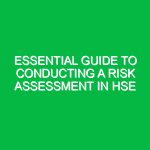Introduction
Good morning, team! Today, we’re holding a Toolbox Talk on a topic that affects all of us, both at work and at home: Noise at Work and Home. Noise is often an overlooked hazard, but it can lead to significant health issues, decreased productivity, and Safety risks. Our goal is to understand how to effectively manage noise in our environments and ensure we maintain a safe and healthy workplace.
The Importance of Managing Noise
Why should we care about noise management? Excessive noise can lead to hearing loss, increased stress levels, and reduced concentration. In a work setting, this can result in accidents and decreased performance. Understanding the impact of noise is crucial for our health and Safety. Furthermore, managing noise can enhance communication, allowing us to work more effectively as a team.
Understanding Noise at Work and Home
Let’s break down the concept of Noise at Work and Home. Noise is any sound that is loud enough to cause hearing damage or disrupt normal activities. It can be classified as:
- Continuous Noise: This type of noise is steady and persistent, like the hum of machinery.
- Impact Noise: This includes sudden noises, such as banging or crashing sounds.
- Intermittent Noise: This is noise that occurs in bursts, like alarms or sirens.
At home, similar types of noise can affect our well-being. For example, loud neighbors, construction work, or even household appliances can contribute to a noisy Environment. Managing noise is essential in both settings for maintaining focus and a calm atmosphere.
Identifying Noise Hazards
As part of our Toolbox Talk, it’s essential to identify potential noise Hazards in our workplace. Common sources of noise include:
- Heavy machinery and equipment
- Power tools
- Transportation vehicles
- Office equipment like printers and copiers
- Environmental factors, such as traffic or construction noise
Take a moment to think about your work area. What noise sources do you encounter daily? Understanding these hazards is the first step in managing them effectively.
Health and Safety Risks Associated with Noise
Now, let’s discuss the health risks associated with unmanaged noise. Prolonged exposure to high noise levels can lead to:
- Noise-Induced Hearing Loss: This is irreversible damage to the hearing mechanism.
- Tinnitus: A condition characterized by ringing or buzzing in the ears.
- Increased Stress: Chronic noise can lead to elevated stress levels, impacting mental health.
- Reduced Concentration: Noise can hinder our ability to focus, reducing productivity.
These risks highlight the importance of managing noise, not just for compliance but for our overall well-being.
Regulations and Standards
Compliance with Regulations is crucial in managing noise effectively. The Occupational Safety and Health Administration (OSHA) has set permissible noise exposure limits to protect workers. According to osha, exposure to noise levels exceeding 85 decibels over an 8-hour workday is considered hazardous.
Additionally, our company adheres to specific policies regarding noise management. Understanding these regulations not only keeps us compliant but also helps us foster a safer and healthier work environment.
Best Practices for Noise Management
So, how can we manage noise effectively? Here are some Best Practices that you can implement:
1. Conduct Noise Assessments
Regularly assess noise levels in your work area. Use sound level meters to measure decibel levels and identify high-noise areas that require attention.
2. Use Hearing Protection
When working in high-noise environments, always wear appropriate hearing protection, such as earplugs or earmuffs. Make sure they fit correctly for maximum effectiveness.
3. Implement Engineering Controls
Whenever possible, use engineering controls to reduce noise at the source. This might include:
- Installing sound barriers or acoustic panels
- Using quieter machinery
- Maintaining equipment to minimize noise generation
4. Administrative Controls
Implement administrative measures such as:
- Limiting exposure time to noisy areas
- Rotating employees to minimize prolonged exposure
- Providing Training on noise awareness and protection
5. Create a Quiet Zone
Designate quiet areas where employees can retreat from noise when they need to concentrate or perform tasks requiring focus. This can be particularly beneficial in office settings.
Practical Strategies for Home Noise Management
Managing noise at home is just as essential. Here are some practical strategies to consider:
1. Soundproofing
Consider soundproofing your living spaces. Simple measures, such as adding rugs, curtains, or acoustic panels, can significantly reduce noise levels.
2. Noise-Reducing Appliances
When purchasing appliances, opt for models designed to operate quietly. For example, look for dishwashers and washing machines with lower decibel ratings.
3. Create a Peaceful Environment
Limit distractions by creating a peaceful environment. This might mean setting boundaries with family members during work hours or using white noise machines to mask disruptive sounds.
Real-Life Scenarios
Let’s consider a few real-life scenarios to illustrate the importance of managing noise:
Scenario 1: Construction Noise
Imagine you are working on an important project, and there is ongoing construction nearby. The loud sounds disrupt your concentration, leading to mistakes. By using noise-canceling headphones or relocating to a quieter space, you can maintain focus and complete your work efficiently.
Scenario 2: Office Noise
In an office setting, excessive chatter and ringing phones can create a distracting atmosphere. Implementing a “quiet hour” policy where employees minimize noise can foster a more productive environment.
Engaging the Team
Now that we’ve covered various aspects of managing noise, let’s open the floor for discussion. What noise challenges do you face in your work environment? How can we collectively improve our approach to managing noise at work and home?
Conclusion
In conclusion, managing Noise at Work and Home is crucial for our health, safety, and productivity. By understanding the sources of noise, implementing Best Practices, and engaging in open discussions, we can create a safer and more efficient work environment. Thank you all for your attention and commitment to maintaining a safe workplace. Let’s work together to manage noise effectively!


